Description and features of the style
English style interiors are a direct reflection of the British mentality. They are also reserved, a little prim, practical, but at the same time very cozy.
Characteristic features of English style design:
- Natural wood. Lots of wood. Traditional design mainly used durable, reliable wood, such as walnut or oak. Not only furniture was made of wood, but also decoration.
- Symmetry. Windows and doors are located strictly symmetrically. Furniture is also installed “mirror-like” if possible.
- Smooth shapes. Armchairs, loungers, sofas have soft, rounded outlines: even the severe-at-first-glance chester (a symbol of English style) has rounded armrests and a back.
- Decorative patterns. Classic English check goes well with floral, plant motifs and stripes.
- Fireplace. Just as it is difficult to imagine a Russian hut without a stove, it is impossible to recreate an English home without a fireplace, or at least its imitation.
If you have carefully studied photographs of British interiors, you probably noticed that they all have the above-mentioned repeating details, but they look completely different. The fact is that the formation of this noble trend took place over 300 years, during which time not only monarchs changed, but the world as a whole: and such global changes could not but affect the appearance of houses.
Each era has its own distinctive features:
- Initial. During the heyday of the magnificent Rococo, the British preferred restrained Romanism and Gothic, and this was the beginning of their own style.
- Georgian. Strict, restrained, but at the same time pompous – based on the architecture of Ancient Rome.
- Victorian. Colonial details intertwined with Baroque solutions.
In the modern English style, the interior retains traditional features, but the design has become lighter and more minimalistic. At the same time, it remains just as restrained, precise and thoughtful.
People with a “British” character who value order, simplicity, and restraint will feel comfortable in a room in the English style. Collectors will also like the interior, because the setting is conducive to demonstrating favorite antique collections.
Color scheme
Due to the abundance of wood in the interior, the basis of the color scheme is brown and its shades. Deep, muted tones of green, blue, and burgundy are chosen as companions. Orange shades are often used – terracotta, ocher, copper, brick.
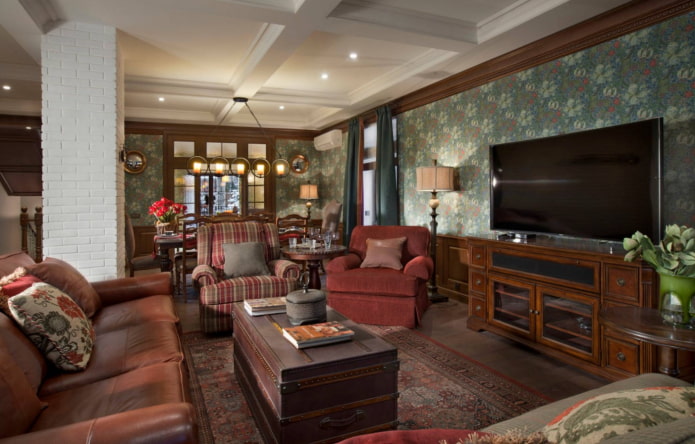
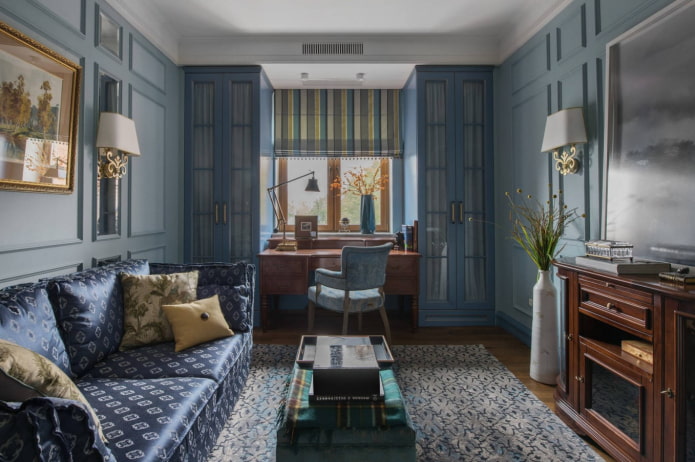
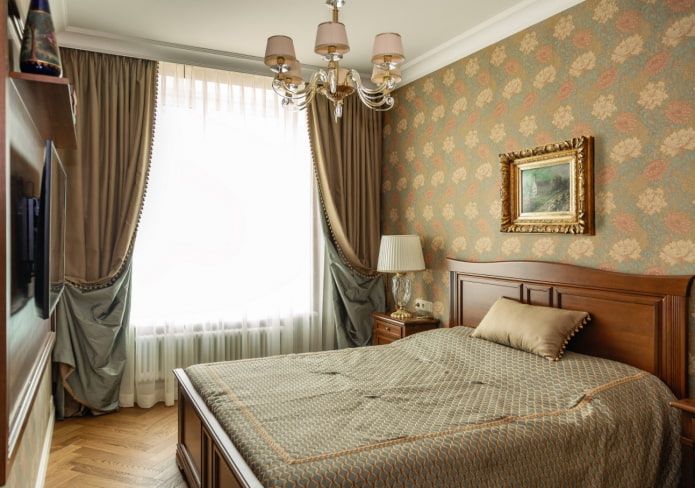
An overly dark interior can be diluted with light, complex tones – ivory, beige, cream. Pure white is rarely used, mostly only as a background – for example, on upholstery with an ornament.
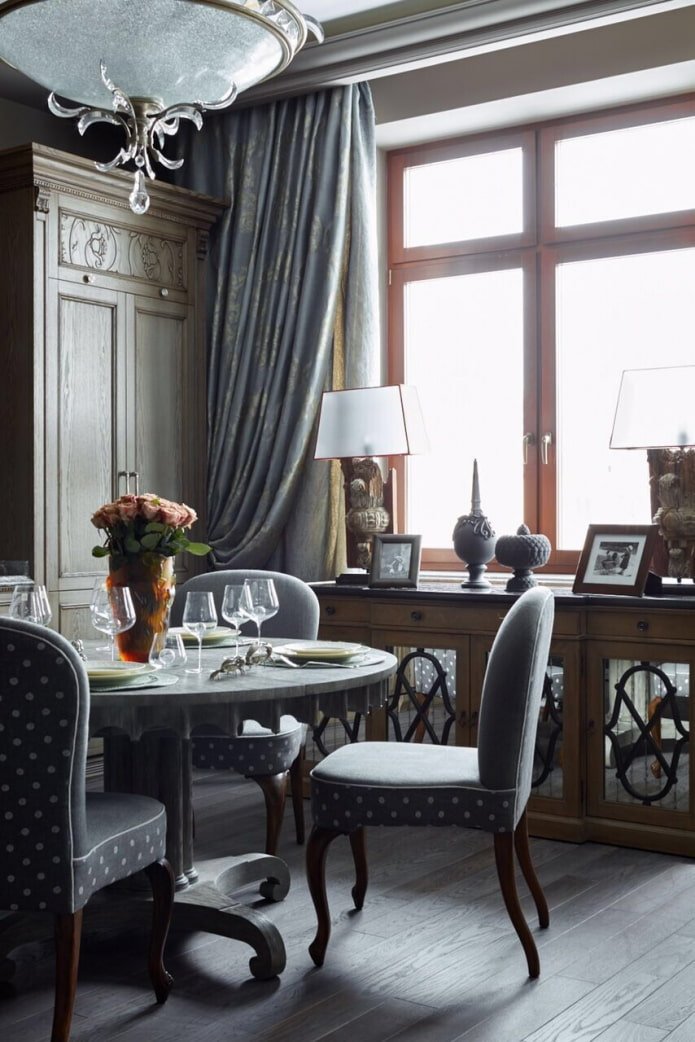
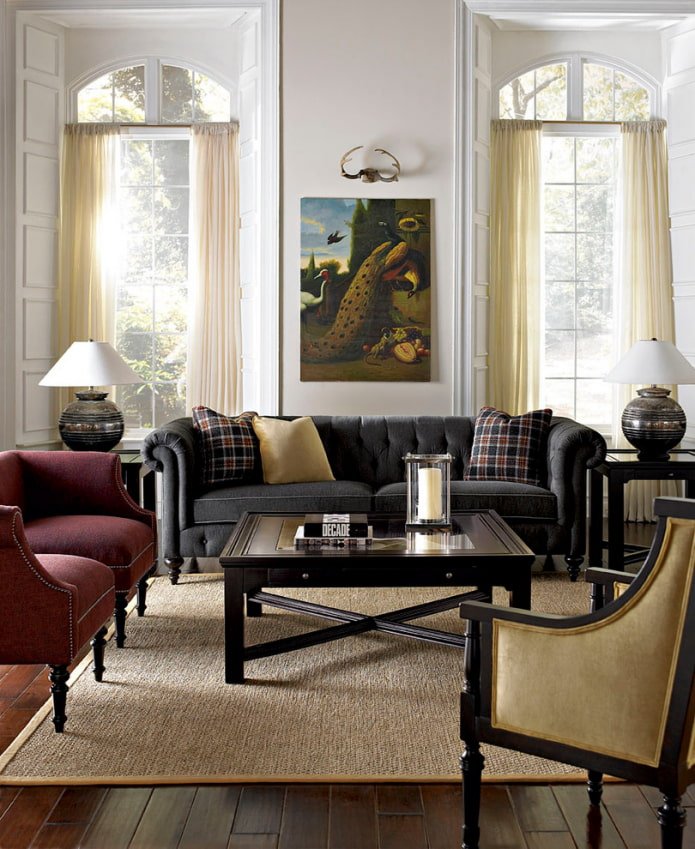
Materials and decoration
Interior design in the English style begins with the renovation of the room:
Ceiling
At the beginning of the 18th century, white surfaces with moldings and stucco were considered traditional. With the development of colonization, beam structures came into fashion, adding dynamics and volume to high ceilings in private mansions.
Walls
There are several ways to decorate walls in the English style:
- Wood. Wooden panels with symmetrical moldings are a classic, often used in living rooms or offices.
- Wallpaper. It must have a pattern: flowers, checkered, striped, flower.
- Paint. Both plaster and wood are painted in a single-color deep shade. The options can be combined: for example, use wood below and bright wallpaper above.
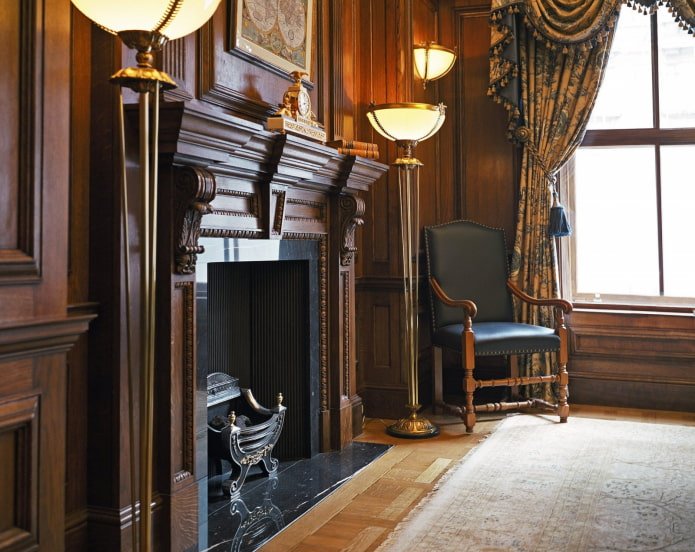
The photo shows wall decoration with wooden panels
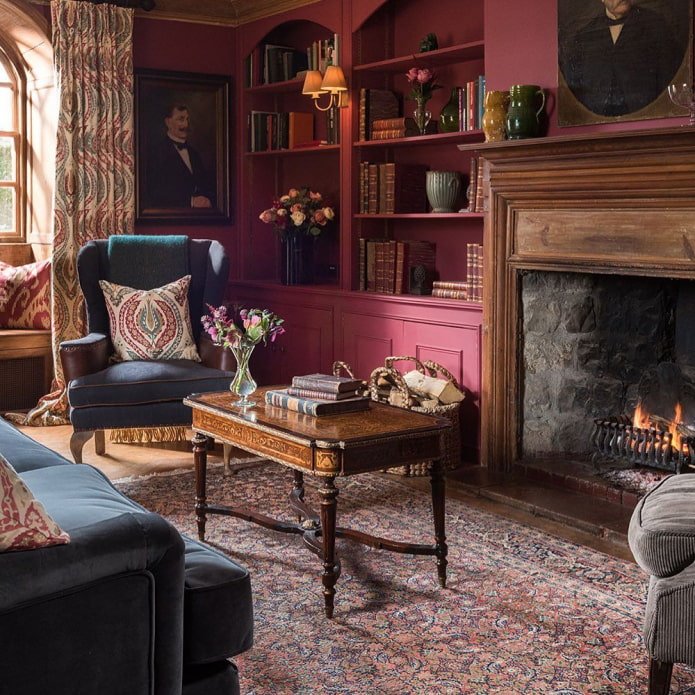
Floor
When decorating living spaces in the English style, choose natural parquet or parquet boards. In kitchens and bathrooms, tiles are acceptable (usually black and white).
Windows and doors
Interior doors and, especially, entrance doors are massive, preferably made of natural wood or veneered. The design is classic. From strict straight shapes with glass to smooth ones with panels, rosettes, capitals. The color is dark wood or plain white.
Windows are often white, large, simple rectangular shapes. Less often – arched.
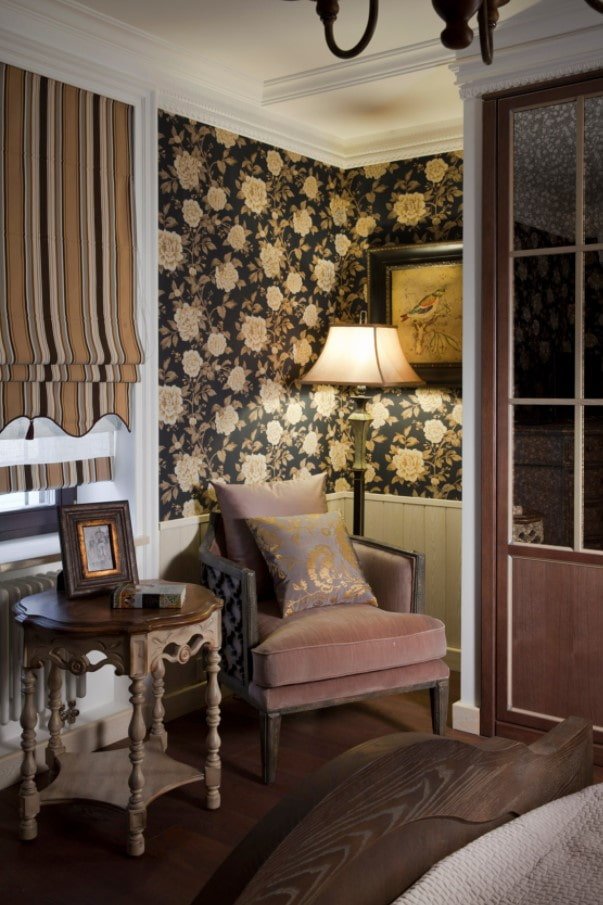
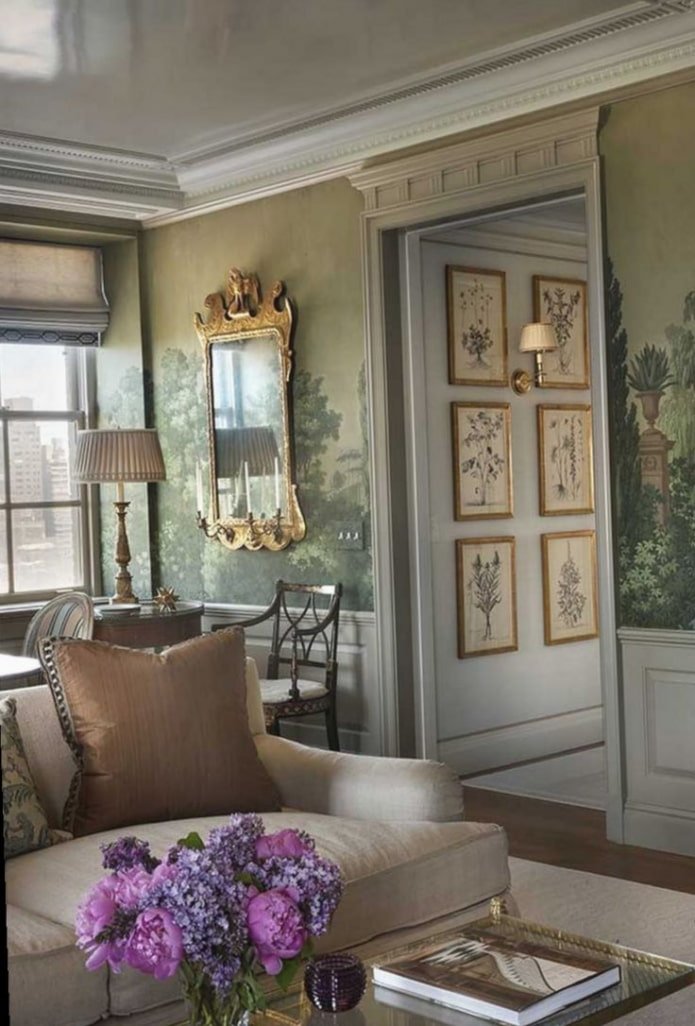
What furniture, appliances and plumbing will suit?
The main element of English design is furniture. It is the focus in any room – from the hallway to the bedroom.
Cabinet cabinets, shelves, chests of drawers – either built-in or bulky, freestanding. The work tables are solid, closed, reminiscent of pedestals or secretaries. The coffee and dining tables have beautiful carved legs. All products are made of wood.
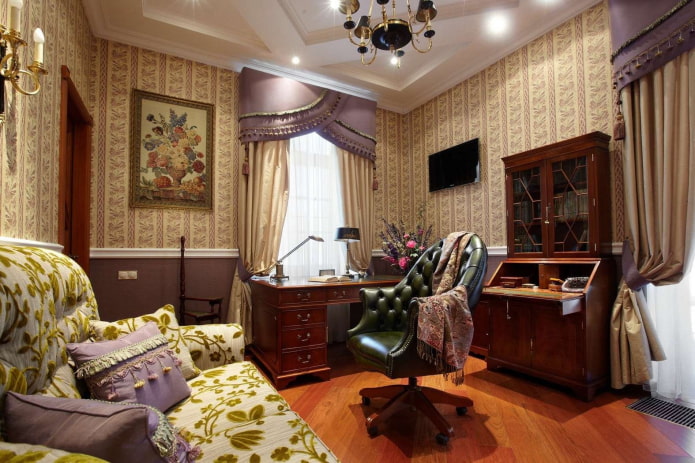
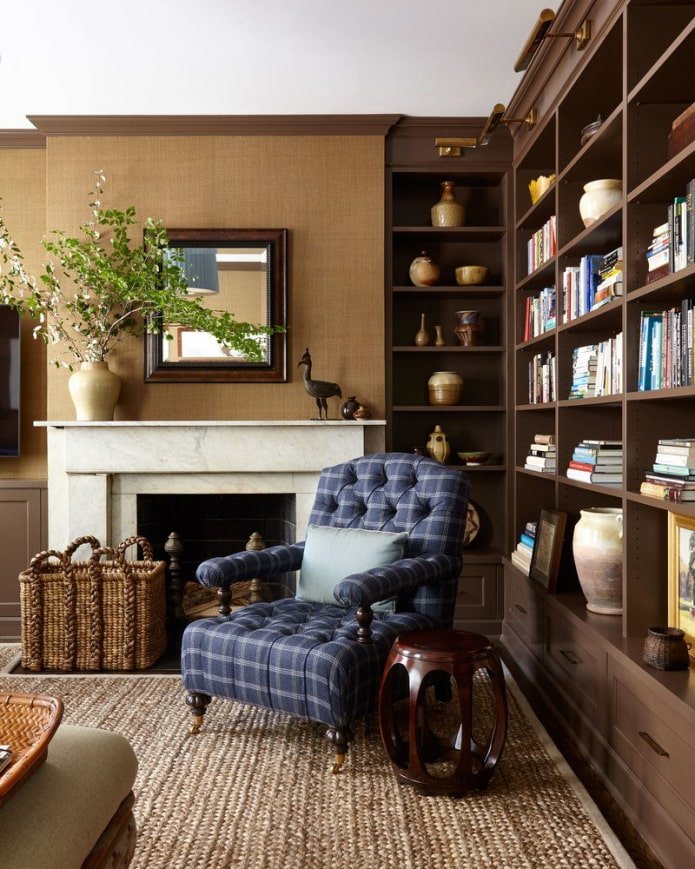

Upholstered furniture is rounded. The armrests of sofas and armchairs are massive and clearly visible. The upholstery can be plain leather (often with capitonné stitching) or patterned textile. Traditional chairs have soft satin seats and high, beautiful backs.
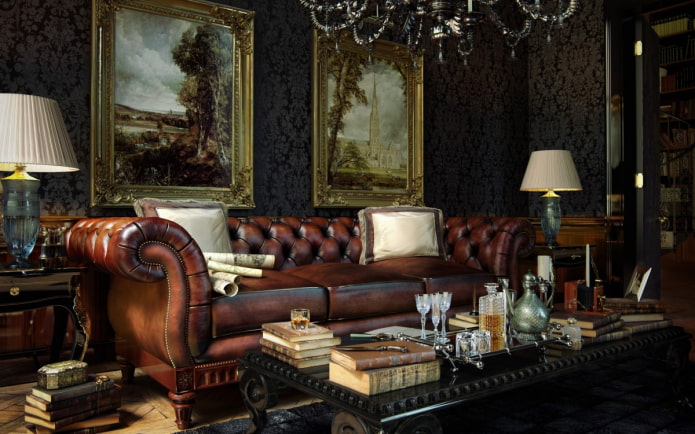
The photo shows a leather Chester sofa
A classic kitchen set with columns, cornices, and balustrades will fit harmoniously into the cooking area. The equipment is selected to match it – deliberately modern items with chrome details will look ridiculous.
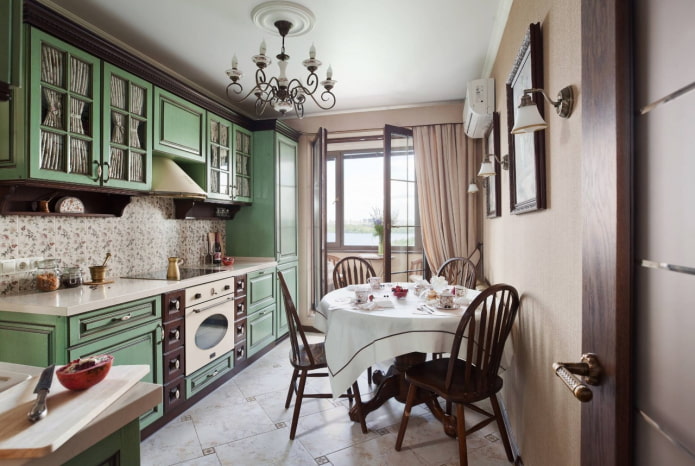
The photo shows a kitchen with aged equipment
The same applies to plumbing – when recreating the English style, choose retro collections. Such toilets and sinks are more expensive, but they meet the task 100%.
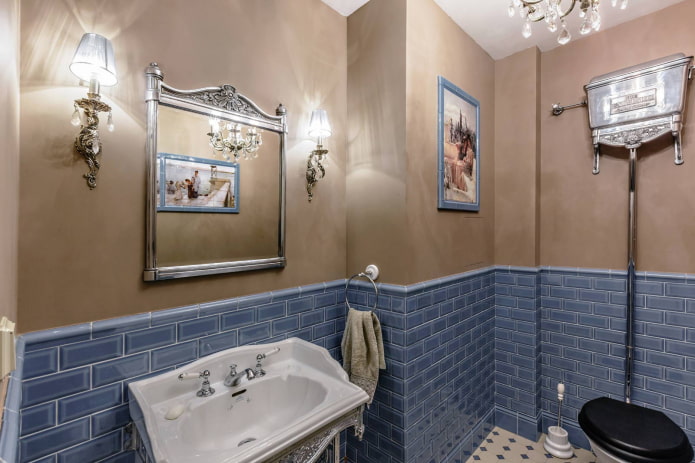
What textiles to use?
The most important part of the decor in the English style is fabrics. The most noticeable element is pillows. They are sure to decorate a soft sofa, armchair, bed.
Don’t forget about the furniture itself: bright textiles on the upholstery effectively attract attention.
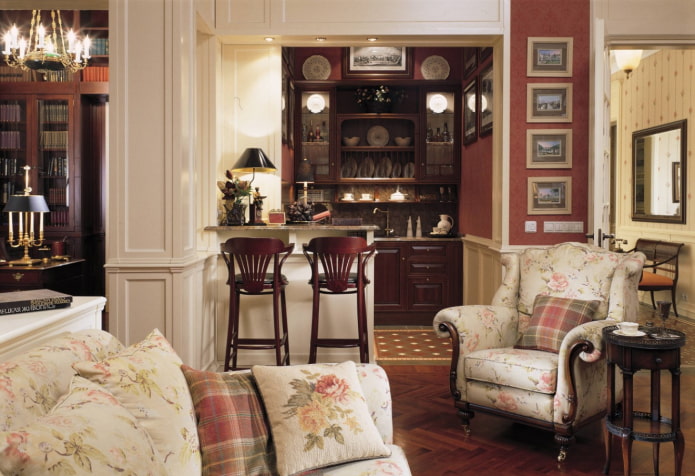
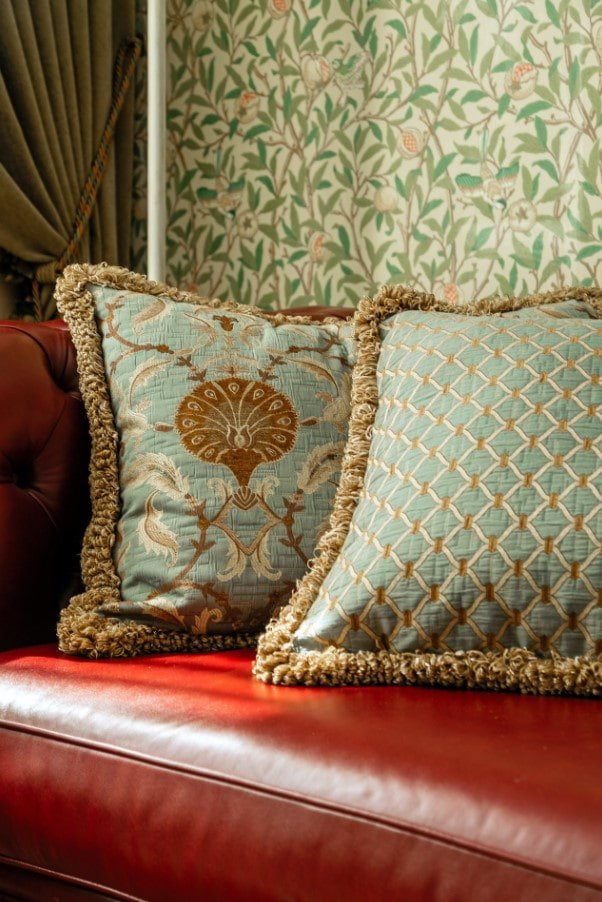
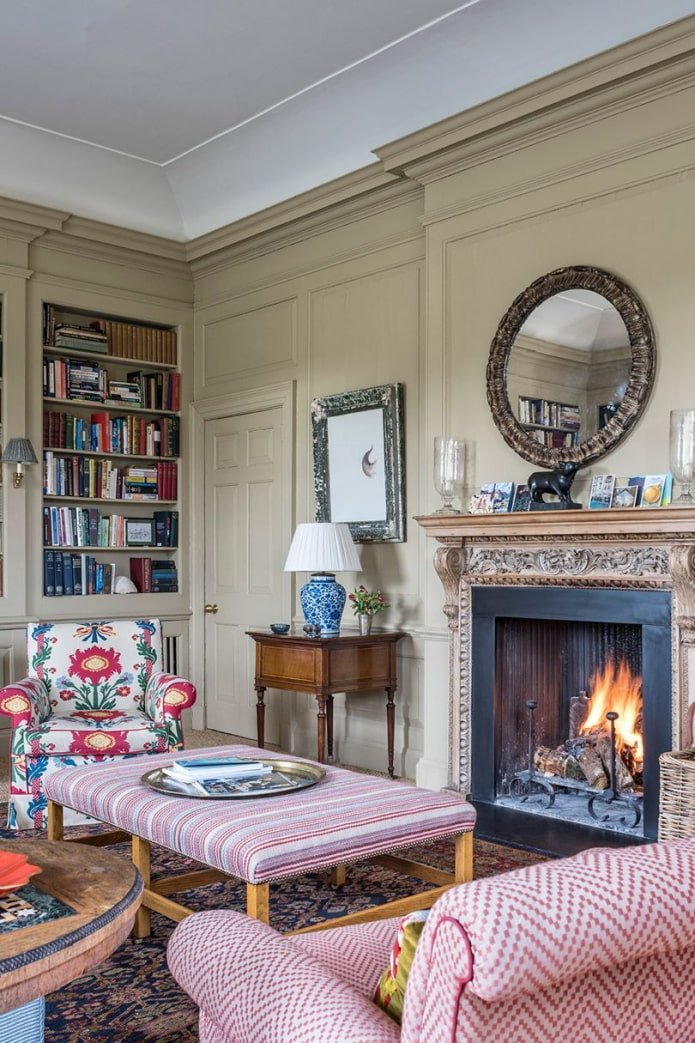
Dense curtains add to the coziness: patterned fabrics can be left as is, and plain ones can be decorated with grabs, tassels, lambrequins.
Carpets with strict geometric or abstract floral patterns are laid in living rooms and bedrooms.
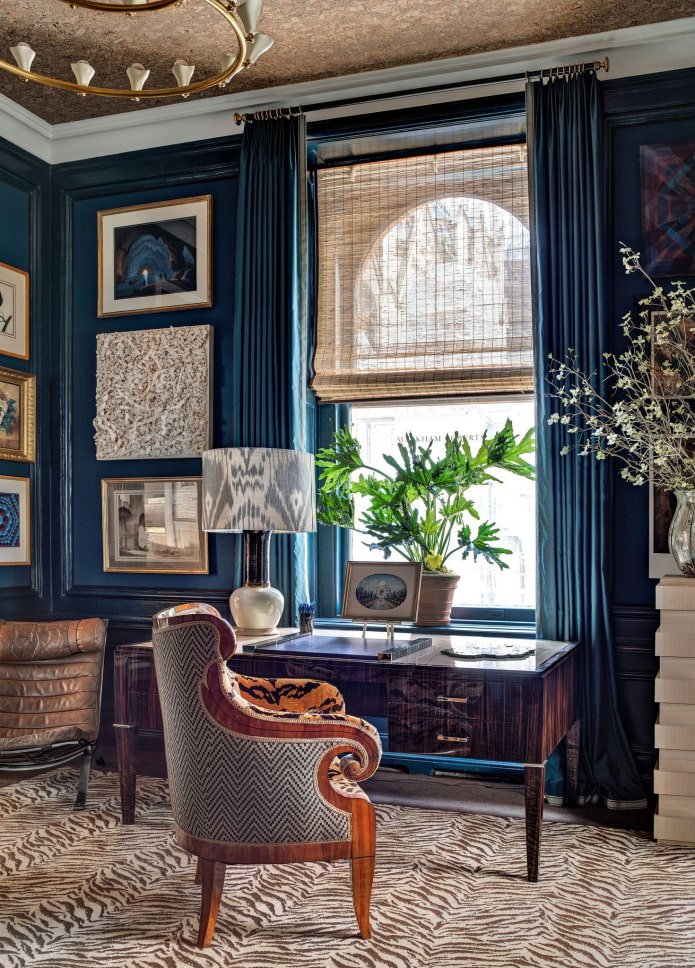
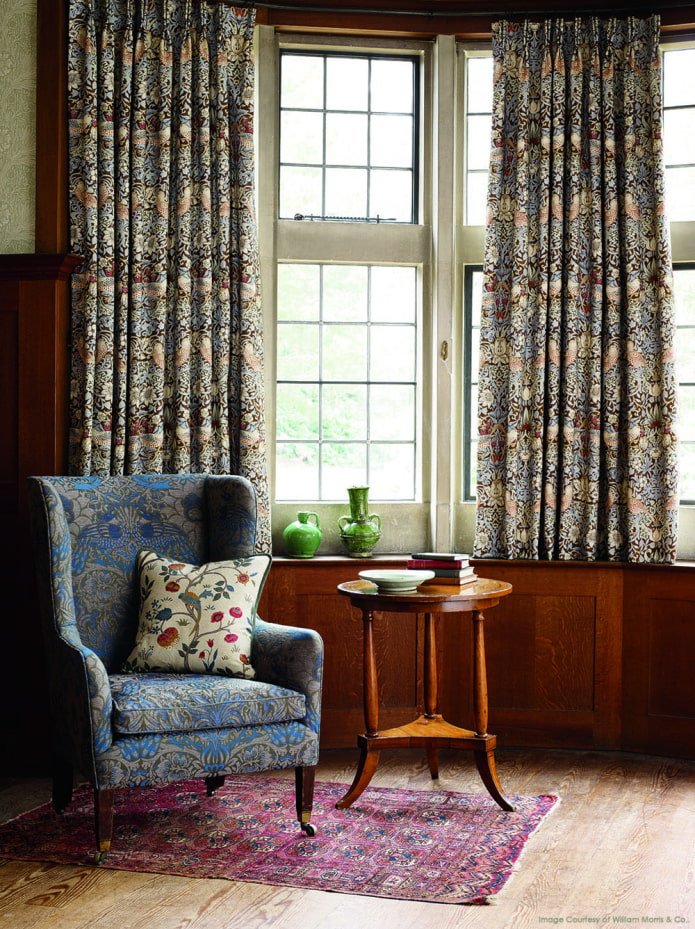
Lighting features
If you read the description of the English style, you probably noticed – it originated before the active introduction of electricity into homes, so initially the rooms were illuminated with candles and lamps. Hence the favorite chandeliers in the design, reminiscent of candelabra.
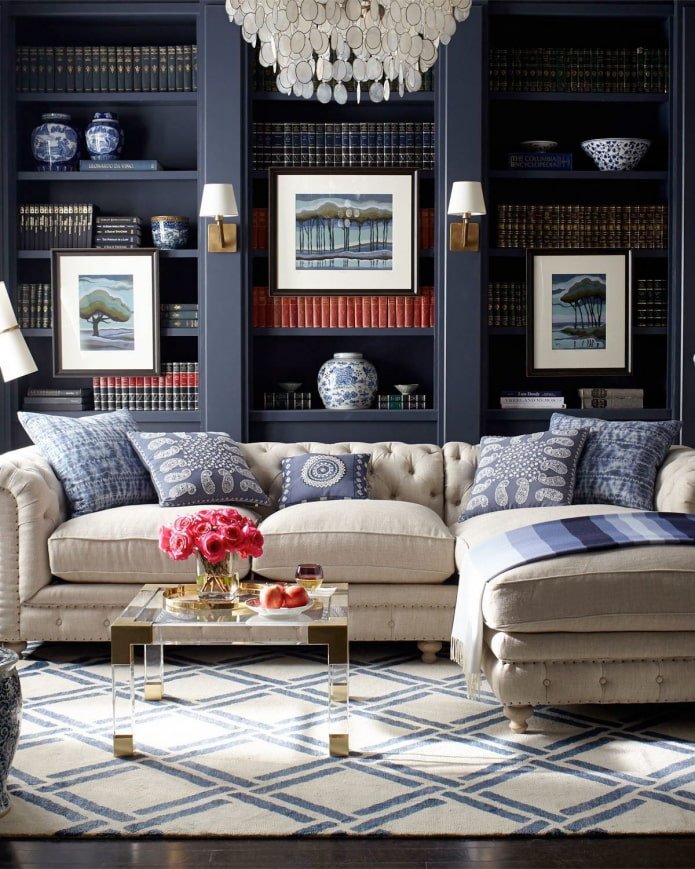
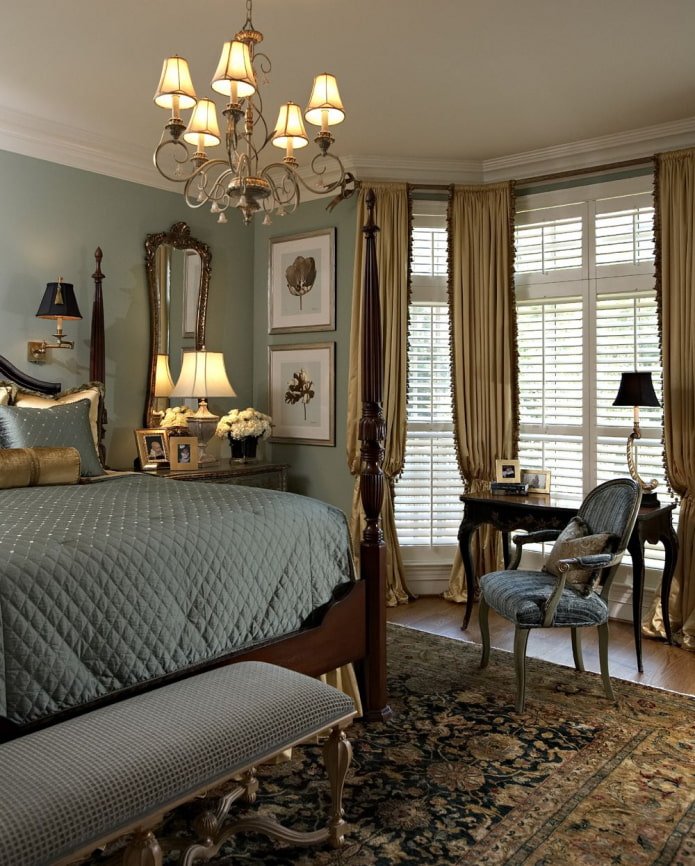
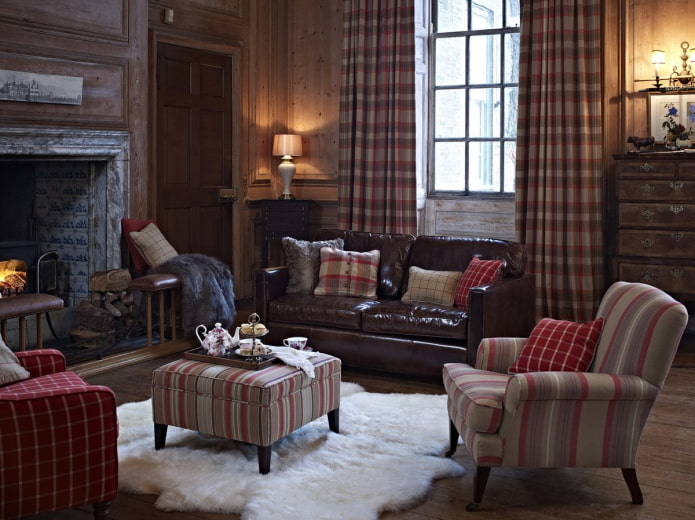
But one central lighting is not enough. To create a cozy, lamp-like atmosphere, floor lamps, sconces, and table lamps are added to the ceiling lamp — sources of subdued, cozy light.
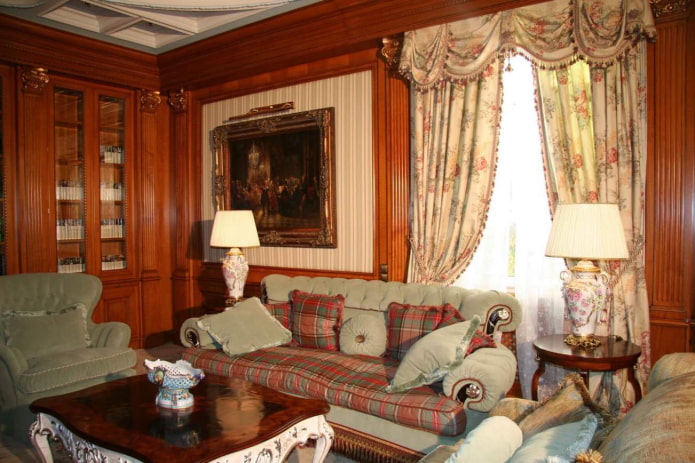
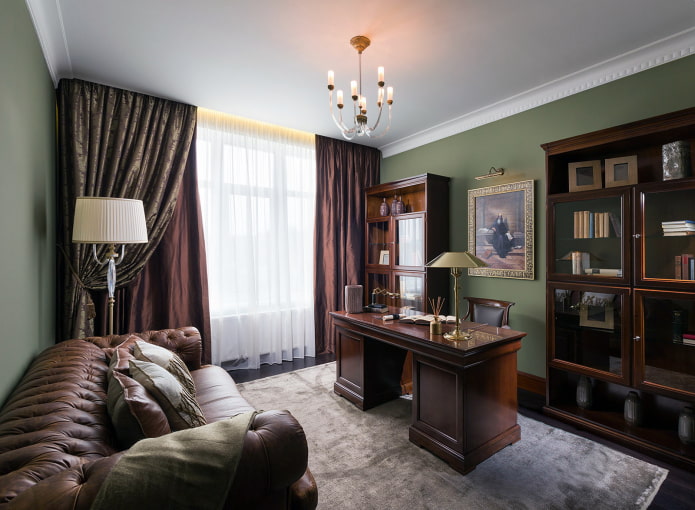
What decor to choose for the interior?
The English style in apartment interiors can be called decorative, because in addition to textiles, rooms are decorated with many other accessories:
- framed family portraits (continuity of generations);
- paintings, posters (the main themes are hunting, nature);
- books (the library should be large and in plain sight);
- beautiful expensive tableware (placed in antique sideboards, buffets in dining rooms or kitchens);
- figurines (on the floor, table, consoles, open shelves).
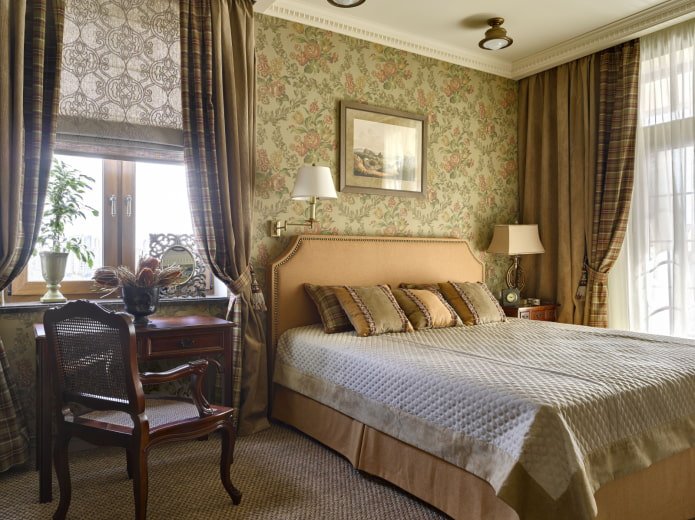
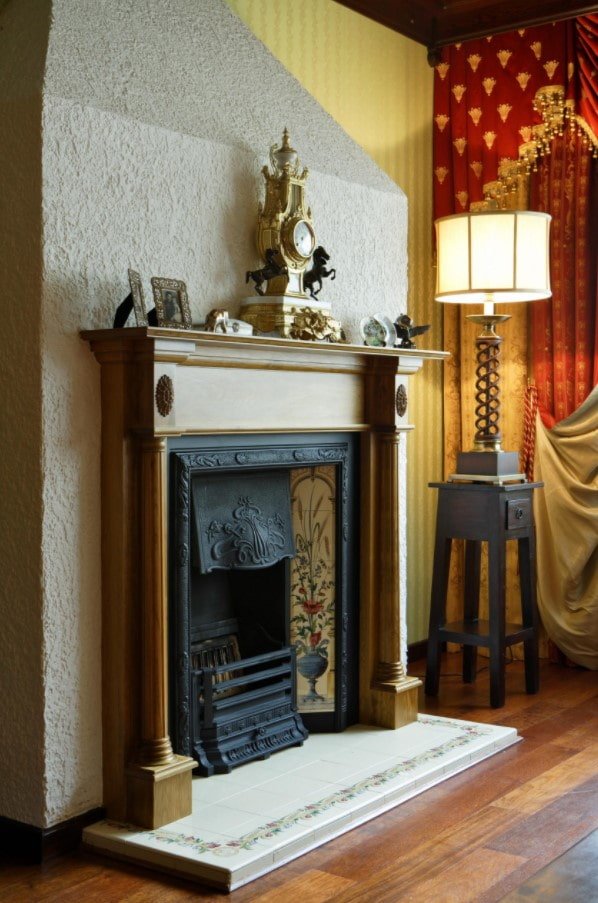

In general, just remember: in the English style there is always something lying or standing on the surfaces. Whether it’s a dining table, a work table or a secretary lid, decorate it.
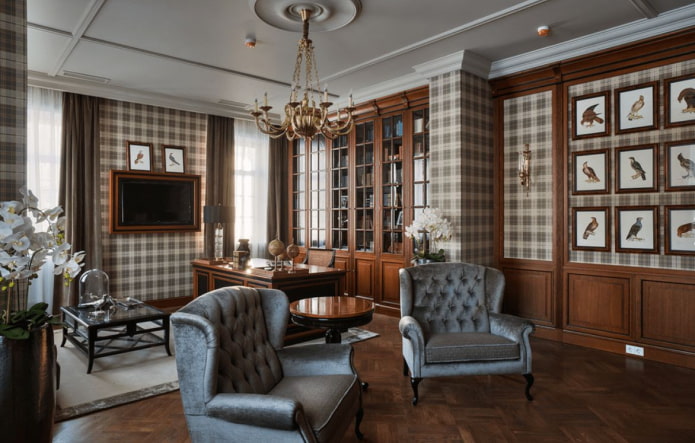
The photo shows wall decoration with images of birds

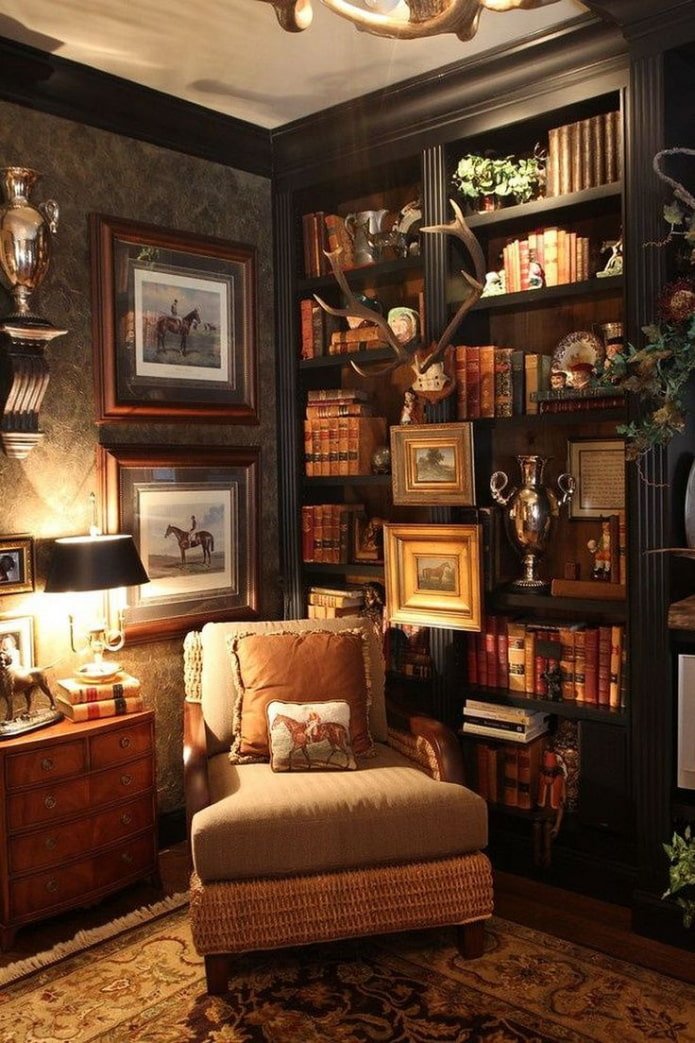
How it looks in the interior rooms?
The embodiment of English design depends on the room with which work is being carried out: according to the British, the room must first of all correspond to its functionality.
Examples of kitchen design
English kitchens are classic. With a large set, beautiful rich curtains, practical tiled floor. The dining area is arranged depending on the layout: it can be left right there (if the area of the room allows), moved to a separate room (if there is a dining room) or placed on the border of 2 zones in the studio.
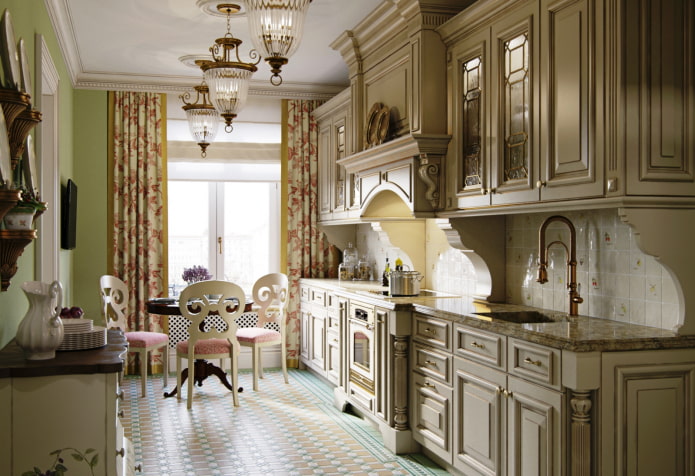
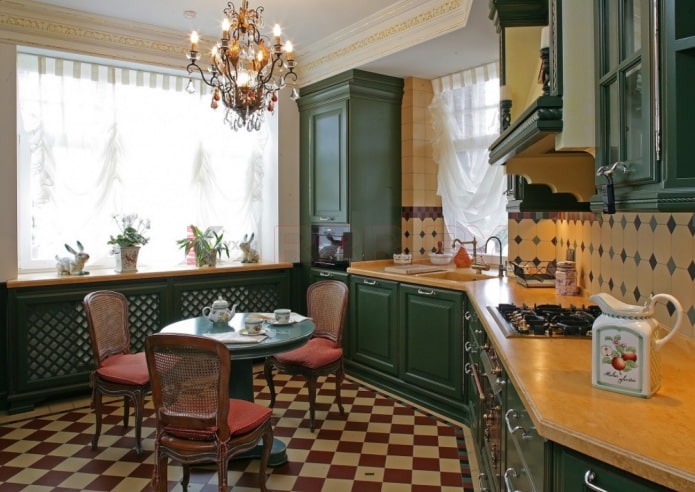
Living room design options
The main and largest room in the house should be conducive to relaxation, communication, and receiving guests. Here, upholstered furniture, a coffee table, and bookcases are a must. It is advisable to put a bar and a fireplace. The staircase, if there is one in the house, also leads into the living room.
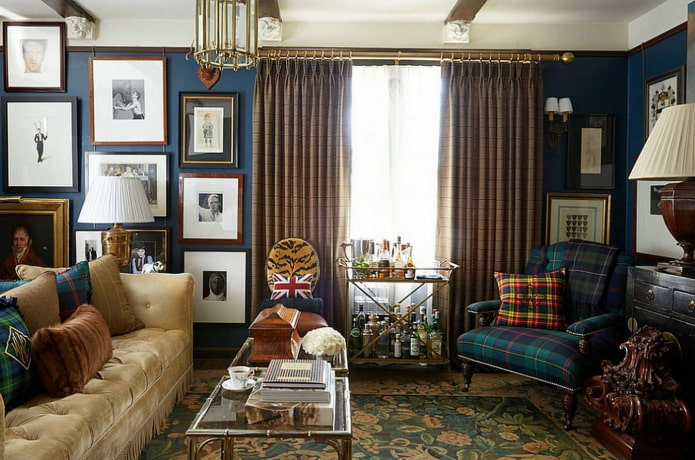
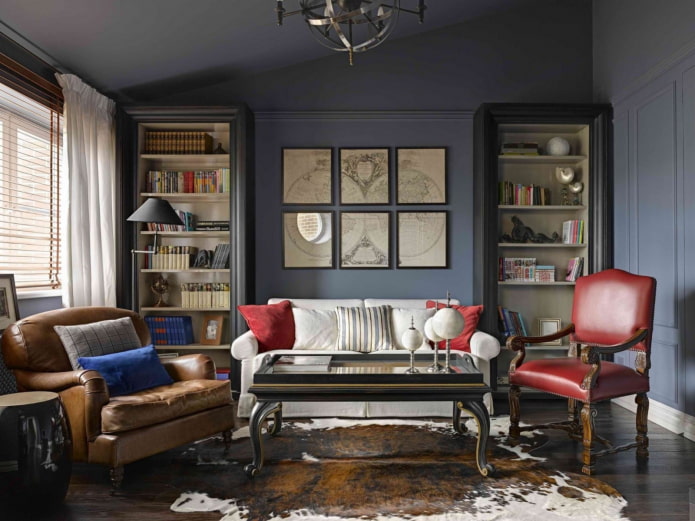
Bedroom design
Bedrooms can be small or spacious. The main thing is that they fit a comfortable bed and bedside tables. The remaining elements – a lounge chair, a dressing table or work table, a chest of drawers – are placed as possible.
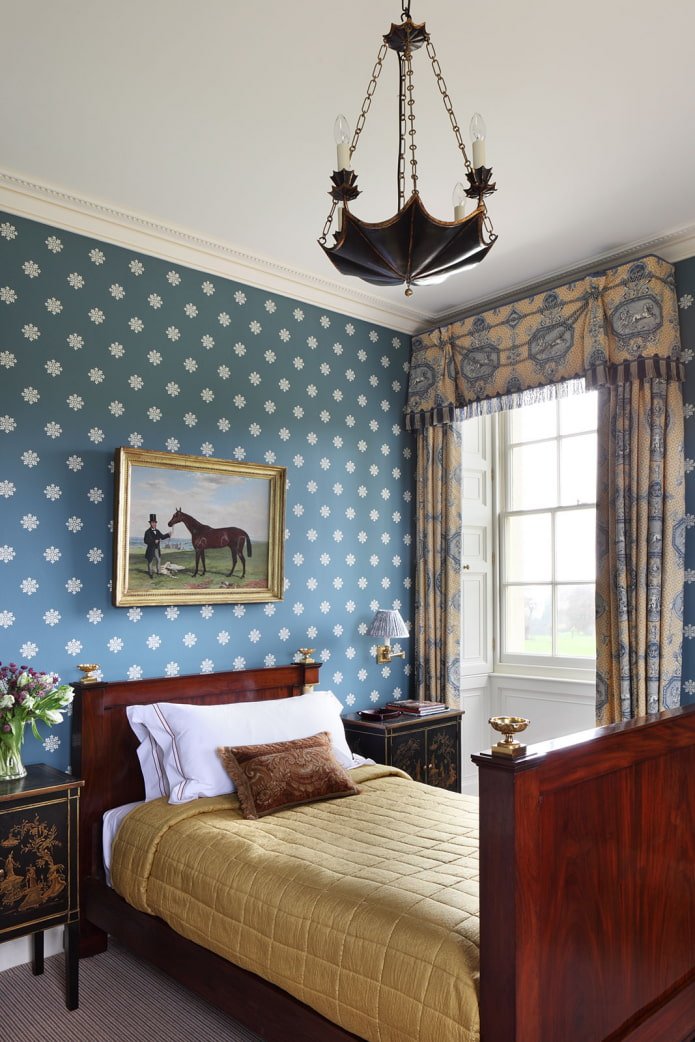
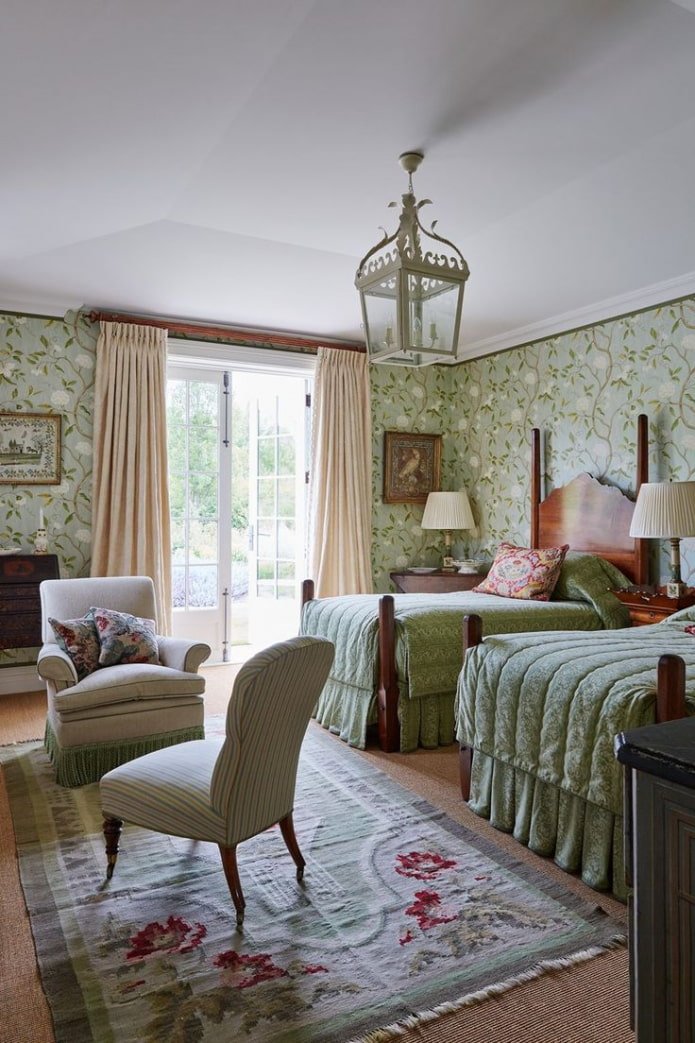
Examples of children’s room design
The children’s room is as restrained as other rooms. For boys, it is advisable to choose checkered and striped prints. Girls will love the floral design.
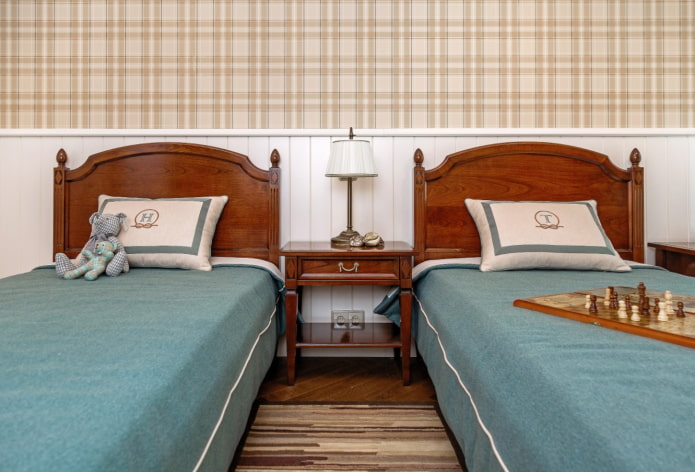
English style in the interior of the hallway and corridor
Since the style initially originated in mansions, the hallways were quite large and more like halls: they had enough space not only for a wardrobe and a mirror, but also for armchairs with a console table – this is where waiting guests were placed.
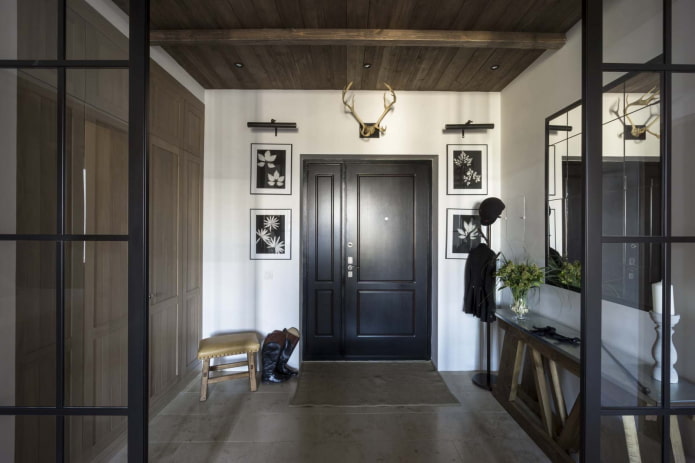
In the photo spacious square hallway in English style
Despite the fact that corridors are walk-through rooms, decor in them will not be superfluous. Hang a few small posters or one large painting.
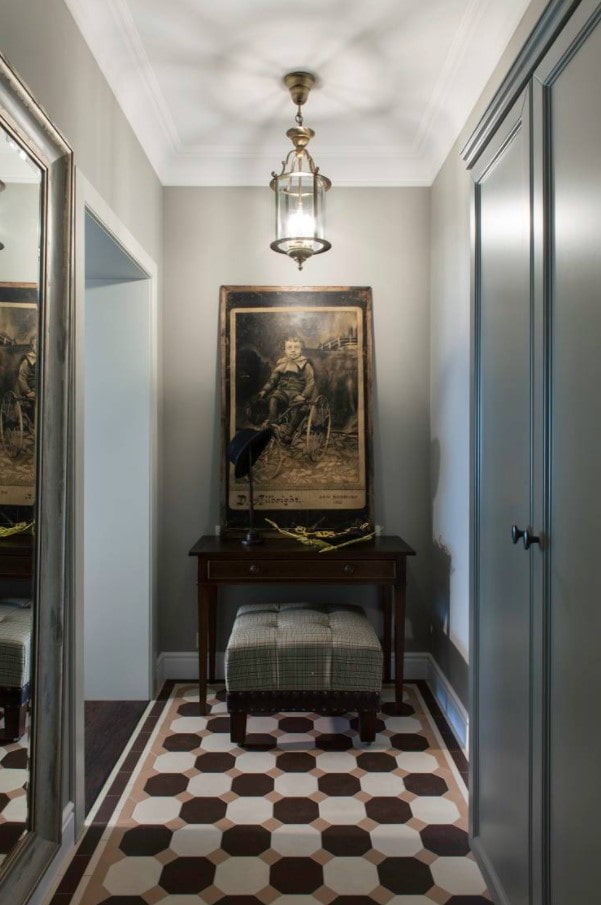
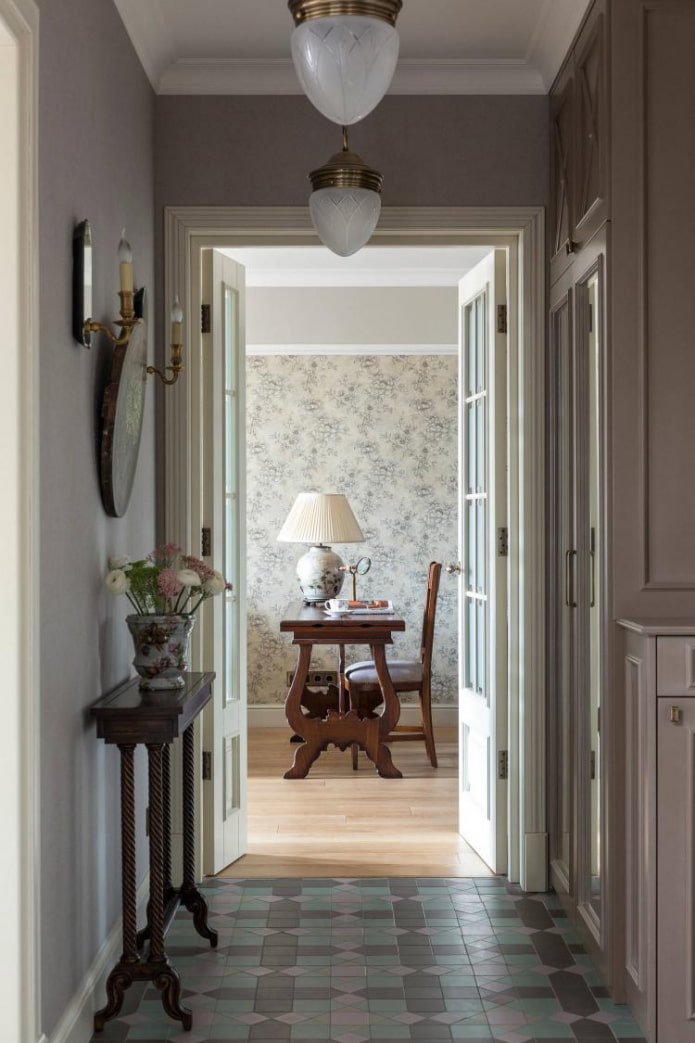
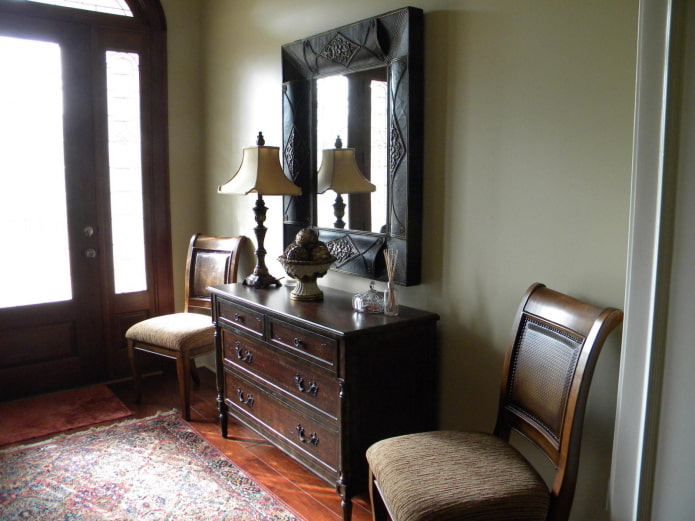
Bathroom design in English style
Bathrooms also originally occupied large areas, so traditionally, in addition to plumbing, they contained a chair with a pouf, a dressing table, and a linen closet. It is advisable to take free-standing bathtubs, but if there is not enough space, it is acceptable to replace them with a built-in bowl or shower cabin.
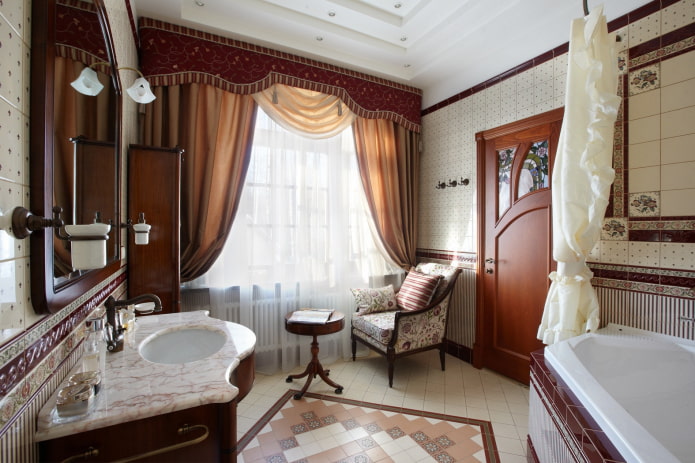
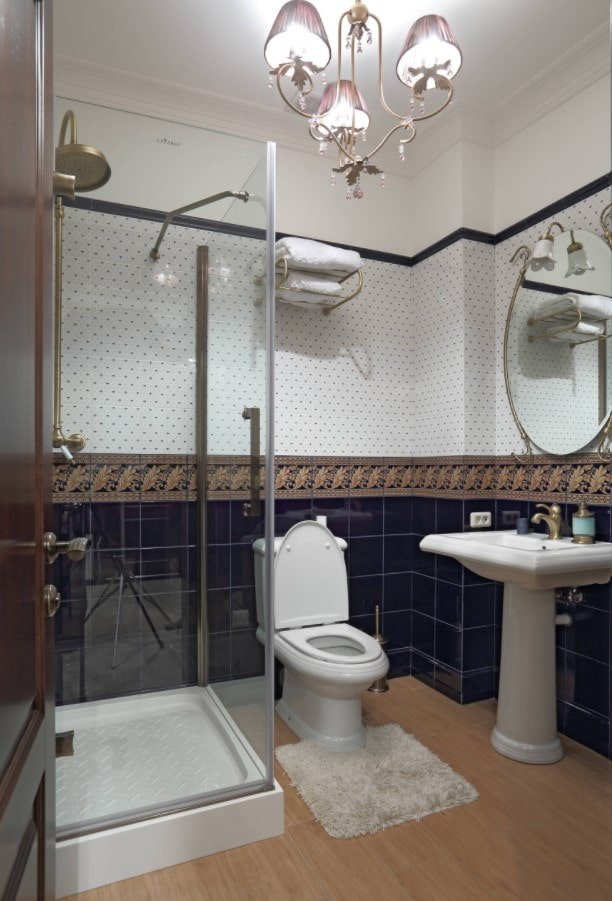
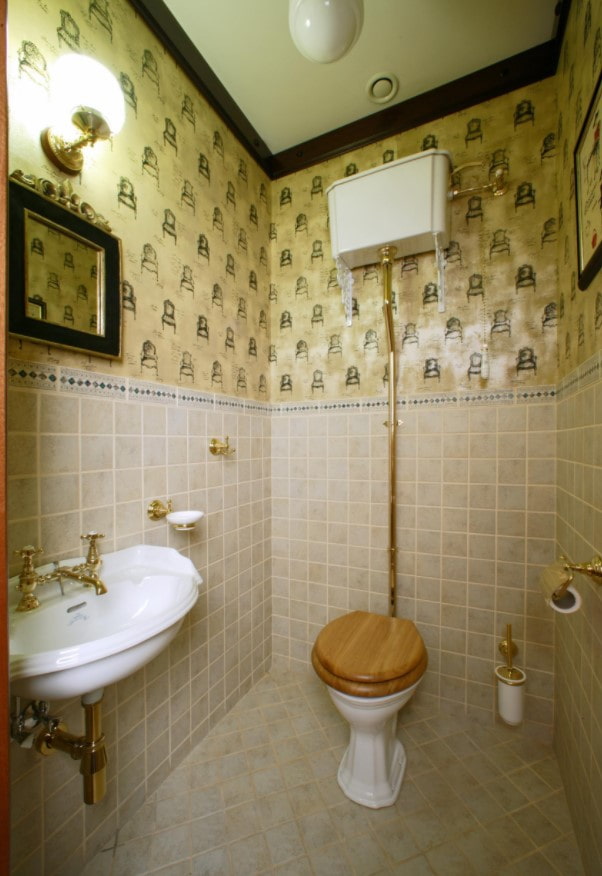
As for the toilet, the most harmonious will be models with a high suspended cistern, or floor-standing toilets with rough straight edges.
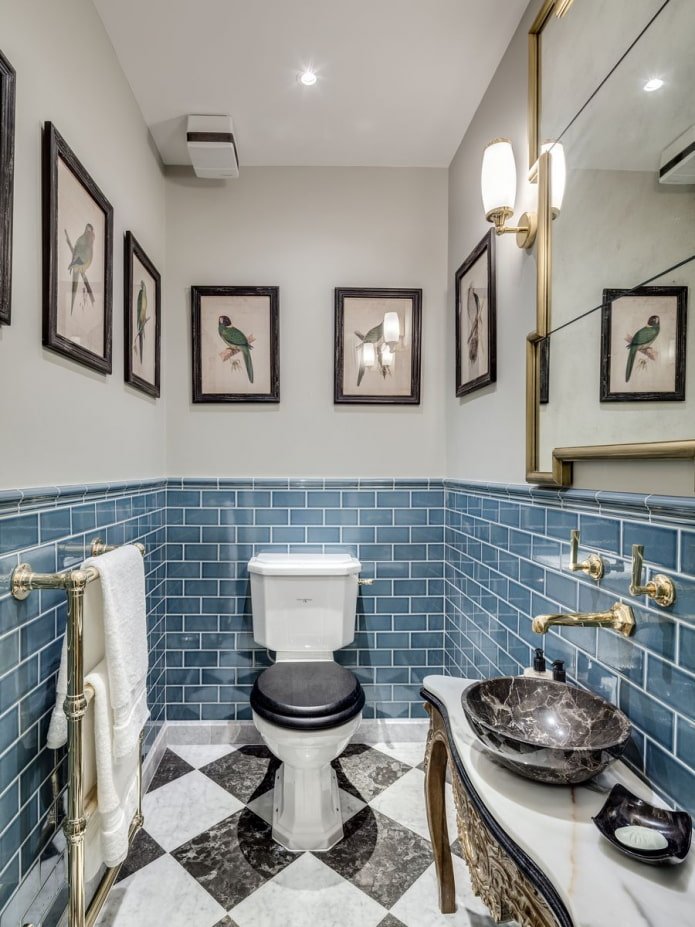
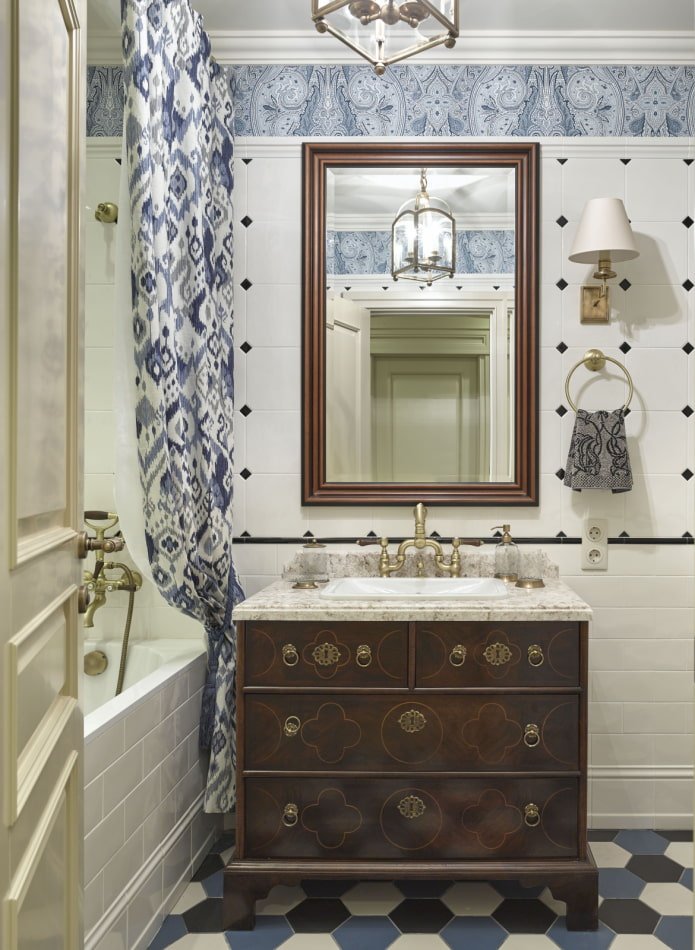
English style office
Most often, it is offices that are awarded English design. Characteristic features of England are massive tables, leather work chairs, comfortable sofas, abundance of wood in the decoration and furniture, cabinets for books, documents.
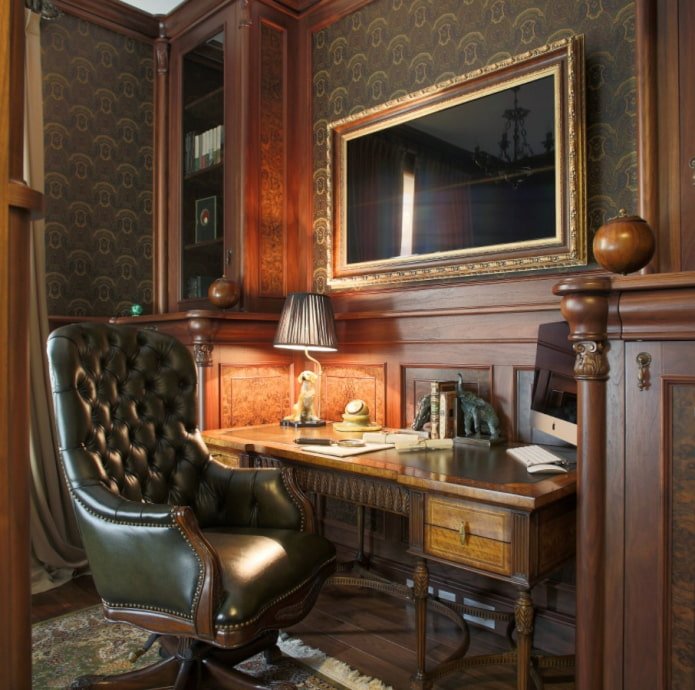
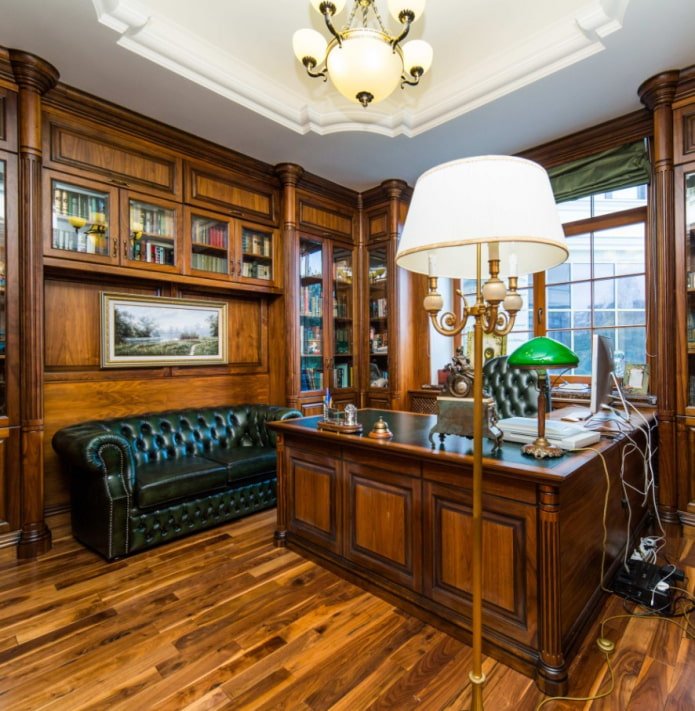
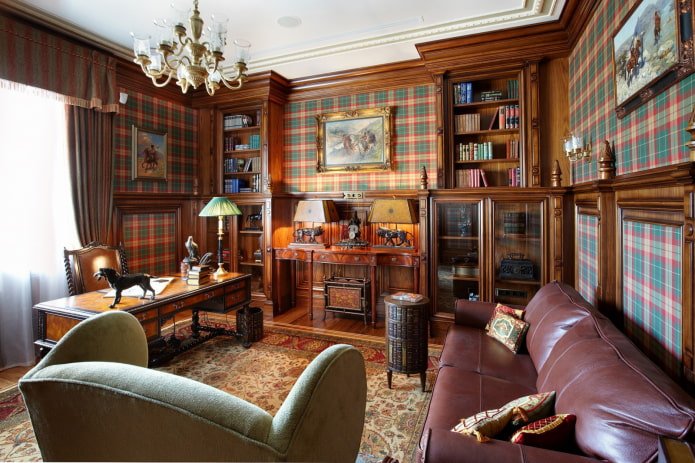
The British were able to preserve all the charm of their traditional style: perhaps that is why today Baker Street-style interiors can be found not only in London, but all over the world!

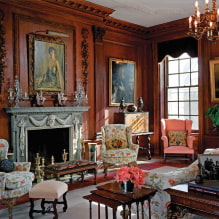
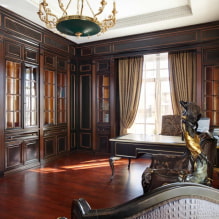
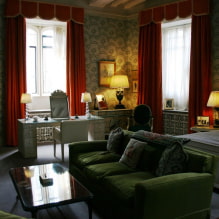
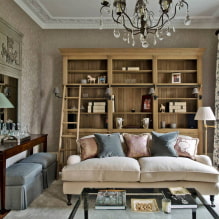
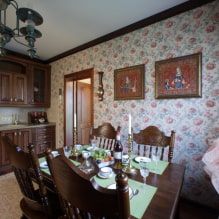
Now reading:
- 10 Creative Ways to Organize the Space Behind Your Door
- Sofa Decorative Pillows: 44 Photos in the Interior for Inspiration
- Sliding wardrobes: advantages, disadvantages and variety of designs
- Kitchen design with a sink by the window: 35 photos, advantages and disadvantages, design tips.
- Shelves above the bed: more than 50 photos and stylish solutions for the bedroom and children’s room